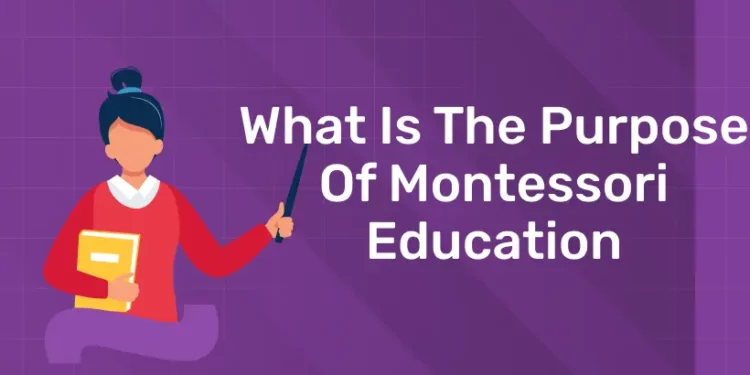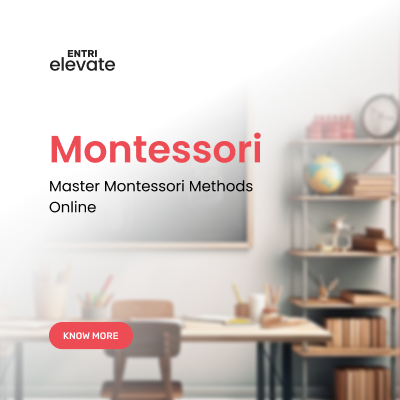Table of Contents
The educational approach known as Montessori is named for Dr. Maria Montessori. She was the first female doctor of medicine graduate in Italy. Maria Montessori approached education from a scientific perspective because she was a doctor. She thought that a person should be prepared for all facets of life through education. She created resources and methods that would encourage pupils’ organic learning growth. Every Montessori classroom shares these. Children that work with these materials and procedures develop a pattern that they naturally apply to reading, writing, and math. Every skill is honed to work in concert with the others.
Unlock your passion for education and shape young minds as a Montessori teacher!
Aims And Objectives Of Montessori Education
- Fostering a favorable attitude toward education in every child. The majority of the learning activities are tailored to each child, meaning they are done in a way that makes sense for them. Since the exercise is tailored to their requirements and preparedness level, they find it appealing. They accomplish a number of successful goals by working at their own pace and doing the task as often as they choose. They cultivate an optimistic outlook on learning in this way.
- Cultivating an enduring curiosity in the child. We will all need to be lifelong learners in our quickly evolving society. A prerequisite for creative learning is a profound, unwavering, and enduring curiosity. Children’s innate curiosity is cultivated into a habit by giving them the chance to explore qualities, dimensions, and interactions in a wide range of engaging learning environments.
- Assisting every kid in becoming a confident, self-sufficient learner. Many students in grade school and high school struggle academically because they lack self-confidence. Tasks at a Montessori school are designed such that the kid builds on prior knowledge with each subsequent phase. accomplishment following accomplishment increases a child’s self-assurance and gives them hope that they can study on their own. These self-assurance-boosting exercises support a child’s healthy emotional growth.
- Encouraging a lifelong curiosity in the child. We shall all need to be students for the rest of our lives in this quickly changing culture. To learn creatively, one must possess a profound, unwavering, and enduring curiosity. The children’s innate curiosity is cultivated into a habit of curiosity through the provision of opportunities to explore qualities, dimensions, and interactions within a diverse range of engaging learning scenarios.
- Fostering the self-assurance that every child needs to become an autonomous learner. Because they lack self-confidence, a large number of students in grade school and high school struggle academically. The way tasks are structured in a Montessori school is that each new level builds on the previous knowledge and skills of the kid. Repeated accomplishments instill confidence in the youngster, enabling them to believe in their own ability to learn. These activities that boost self-esteem help children develop healthy emotional skills.
- Forming self-starting and persevering behaviors. The child learns to engage in activities on his or her own by being surrounded by interesting materials and learning experiences that are tailored to inner needs. This usually leads to an initiative habit, which is a necessary trait for leadership. “Ground Rules” stipulate that a task must be completed once started and that items must be replaced after the task is finished. A completion habit is progressively formed as a result of this expectation of completion.
- Sharpening the ability to discriminate and judge. Sorting and matching activities challenge the child, calling for his/her noting similarities and differences in size, shape, color, texture, odor, sound, etc. — in short, sharpening sensory acuity. Thus the child’s senses learn to report more accurately the various qualities describing his/her expanding world.
- Promoting the child’s social development. The youngster gains cooperation skills by collaborating with others. Through cooperative activities where “ground rules” curb impulsivity, the kid progressively gains comprehension and appreciation of the meaning of “respect for others.”
- Aiding in the child’s imaginative and creative growth. Form, color, music, and word, as well as the child’s inner waking, are given opportunities to translate into movement. Through the process of carefully crafted practical-life, sensorial, mathematical, music, art, language, and science activities, the child gathers thousands of distinct perceptions that are later utilized to understand words, ideas, and concepts necessary for proficient reading. This process is known as “mental building blocks.”
- Assisting in the development of sensory motor abilities through tasks including the manipulation of numerous specifically made devices. Engaging activities that utilize both large and small muscles help the youngster develop more motor control. Many of the challenges require the kind of muscle control and movement that are necessary to become proficient at handwriting.
Learn the Montessori philosophy, classroom management techniques, and hands-on activities!
How Does Montessori Education Works?
1: What is the primary focus of the first plane of development in the Montessori method?
For the Montessori setting to be successful and exciting, deliberate curriculum and lesson design are required. Teachers teach lessons to the children in order to carry out the Montessori curriculum. The resources children require to freely explore, study, and draw connections in order to meet learning objectives are given to them after a lesson. Instructors watch while the kids investigate. This is an opportunity to enable children to learn new skills and information while recording their progress, even when intervention may be required.
Making a Montessori curriculum is the first step towards implementing Montessori techniques in the classroom. Children should be able to study in five main areas: language, cultural studies, mathematics, practical life, and sensory learning.
The carefully chosen and crafted learning tools in Montessori classrooms allow kids to explore and learn at their own speed. Children can identify and learn from their mistakes on their own because to the self-correcting nature of these items. Instead of teaching, a Montessori teacher’s job is to support and encourage learning while fostering a child’s innate desire to learn.
Whether you run a daycare center or intend to begin homeschooling your children, the effectiveness of your program is influenced by the layout of your classroom. Typical classrooms don’t feel or look like Montessori classrooms. Conventional classrooms can appear disorganized and have an overwhelming amount of vibrant materials and colors. The atmosphere in a Montessori classroom is intended to be soothing, cozy, and perceptive of the needs of the child.
Click here to learn more about Entri Elevate Montessori Teachers Training program!
CONCLUSION
Fostering a child’s innate curiosity and promoting their whole development—cognitively, socially, emotionally, and physically—are the two main goals of a Montessori school. Key to developing critical thinking, problem-solving abilities, and a lifelong love of learning is the prepared atmosphere that Montessori education offers, which promotes independence, self-directed learning, and hands-on discovery. It values every child as an individual with special potential and encourages social peace, self-control, and responsibility. The ultimate goal of a Montessori education is to enable kids to grow into competent, compassionate, self-assured adults who make meaningful contributions to both their local communities and the wider world.
Frequently Asked Questions
What are the benefits of Montessori education?
Independence, critical thinking, problem-solving abilities, and a love of learning are all fostered by a Montessori education. Additionally, by honoring each child’s unique interests and pace, it fosters emotional development and social development through interactions between children of different ages.
How does Montessori education impact a child's development?
Montessori education meets children’s physical, emotional, social, and cognitive requirements in order to promote their complete development. It helps kids grow into self-driven learners, assured problem solvers, and responsible adults.
Can Montessori education be integrated with traditional schooling?
Yes, there is some room for integrating Montessori concepts into traditional education. Within more traditional educational frameworks, parents and educators can integrate experiential learning, respect for the child’s pace, and independence-building.
Are Montessori schools expensive?
Because of the materials utilized and the particular training that teachers receive, Montessori schools can be more expensive than typical schools. However, in order to increase the accessibility of Montessori education, several schools provide financial aid and scholarships.










